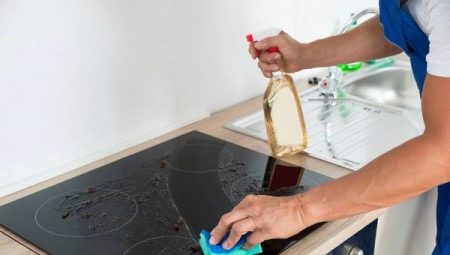In the process of cooking, the hob will inevitably become contaminated and must be constantly washed, cleaned, wiped so that the working surface looks neat. When purchasing a glass-ceramic stove, you need to know that it requires more careful care than its gas counterparts. In this article, we will talk about this shiny glossy surface and how to wash it from carbon deposits at home.
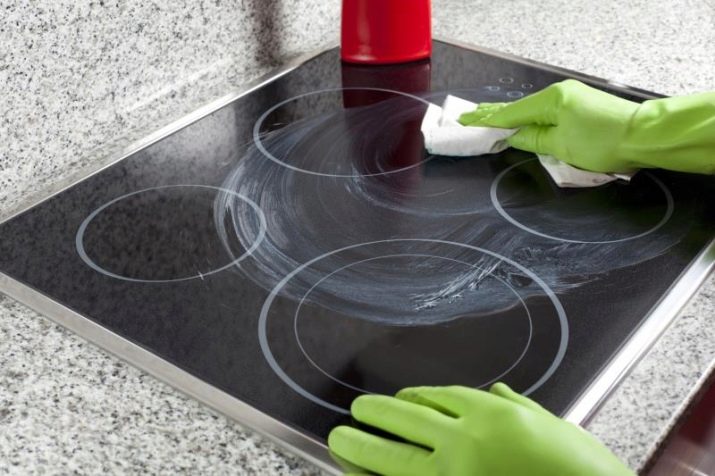
Care Rules
Just note that this hob is very functional and convenient to use, but, unfortunately, it is too vulnerable to various types of damage. The smallest fingerprints, dust, not to mention oil and accidentally spilled liquid are very clearly visible on it. In order that the cleaning of glass ceramics does not become a real test for you, try to clean it every day after cooking. In this case, you only need a sponge or microfiber cloth and cleaning agent. Often, housewives use liquids for washing glasses and glass surfaces for these purposes.

When cleaning the hob, the following rules must be observed:
- Before cleaning, be sure to disconnect the electric stove. These stoves have a touch panel and, in order not to accidentally turn on the burners during cleaning and not to burn themselves, so that there is no short circuit when in contact with water, it is better to protect yourself and others;
- Do not clean until the panel has cooled down (you can get burns on the skin of your hands, in addition, cracks may appear on the glass ceramic);
- use a special tool designed for cleaning glass-ceramic surfaces;
- hard scouring pads, knives, brushes and other objects that may damage the surface cannot be used for cleaning;
- After cleaning, wipe dry and polish the panel with a soft cloth.
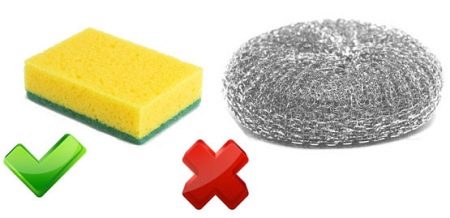
Never wait until the surface of the glass ceramic plate is very dirty, better remove stains immediately, thereby you save a lot of effort and time when cleaning.
To prevent scratches on the panel, use dishes with a flat bottom, without cracks and chips. Otherwise, it will be simply impossible to get rid of scratches on the coating of the plate.
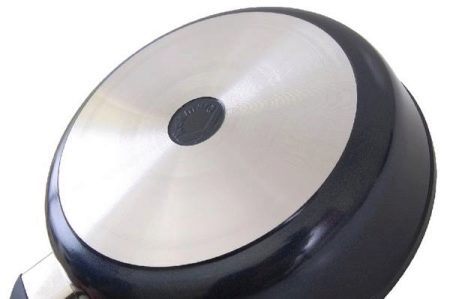
Ways to get rid of stains
If cleaning with a liquid or ceramic cream did not help you, you must use a special soft scraper or a plastic spatula. It is important to remember that you need to work with the tool carefully, without pressing or pressing on it, so as not to scratch the plate. Hold the scapula at an angle of 30 degrees and make gentle translational movements back and forth until the carbon deposits move away. Then apply cleaning fluid and rinse off any remaining dirt.
The scraper will help remove stains from sugar-containing products, wipe aluminum foil and plastic. Manufacturers warn that sugar must be removed from the surface of the plate immediately, since its crystalline surface is able to burn through small holes in the coating.
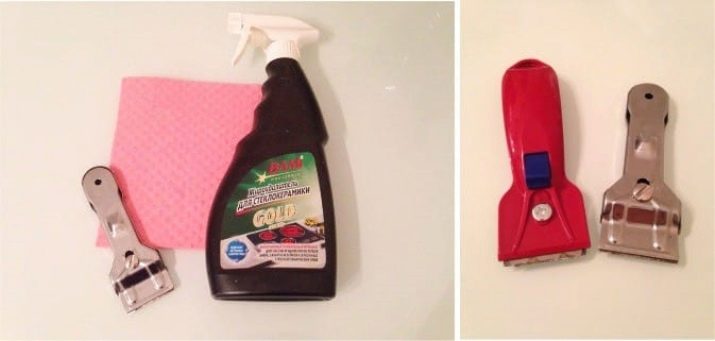
If the spots are too difficult, you can use olive oil. This is a great method to combat even the most persistent soot. You need to apply a small amount of oil on a soft cloth and apply it directly to dirt. The exposure time is approximately 30 minutes, during which the carbon is softened and then easily removed with a scraper or cloth. Then you need to wash and polish the ceramic surface with a soft cloth.
You can clean the glass and ceramic surfaces with lemon and baking soda.
This method is very effective for chronic sunburn and stubborn stains. Wherein Do not be afraid of scratches. You need to add a little water to the baking soda to make a slurry. Next, apply it on the stove and let the mixture dry. Then you need to drip lemon juice on the soda, in this case, the process of splitting fats. Wash away any remaining gruel and polish the stove as usual.

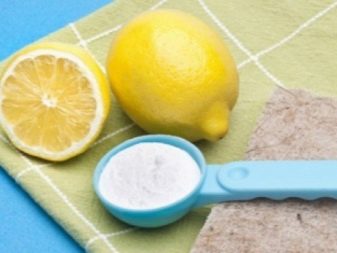
Ammonia will help you easily cope with salty stains and milk stains on the panel. To do this, dilute 50 grams of ammonia in 250 grams of distilled water, pour the resulting liquid into a spray bottle and spray onto a glass-ceramic surface. Leave for deeper exposure for 5-10 minutes. After this time, wipe the plate with a napkin and polish it with a soft cloth.
Another way helps to get rid of carbon deposits on a ceramic surface in literally five minutes. For this you will need the usual table vinegar. It must be diluted with water in the proportions 1: 1. Also add the resulting liquid to the spray bottle and spray it onto the surface. Leave for deep exposure for several minutes, then rinse with a damp cloth and wipe the stove dry.
It should be noted that vinegar is still fighting bacteria and microorganisms, so after such a cleaning you will not have an unpleasant odor.
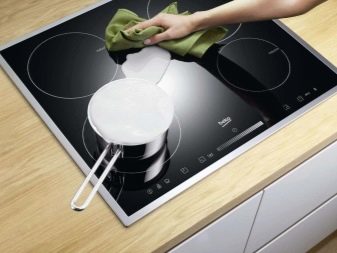
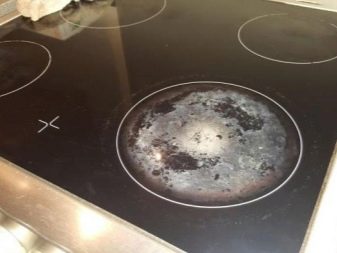
A simple liquid dishwashing liquid will help you cope with simple pollution. With it, you can remove stains immediately after cooking. It is important to remember that a dishwashing sponge should not be used when washing a glass-ceramic surface, since traces of grease or other detergents may remain on the stove, which will subsequently lead to the formation of stains and new spots, and possibly even minor damage to the coating.
To clean it from dirt, apply liquid to a soft cloth and wipe the surface of the stove. Then remove traces of the product and foam with a damp sponge and wipe the panel dry.
It is worth noting that now they have gained great popularity melamine sponge. They are made of melamine foam, which cleans almost any surface well without the use of additional detergents. Outwardly, this sponge resembles foam, but it is more elastic and much softer than usual. To wash the ceramic surface, just wet the melamine sponge with water and wipe the stove. You do not need to make additional efforts, you will be surprised how quickly and efficiently this thing copes with its task. After you just wipe the panel dry and polish.
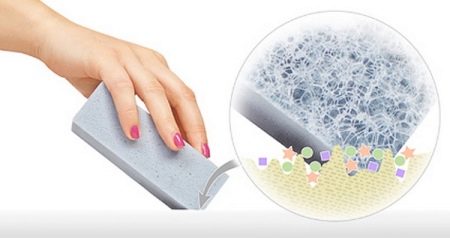
Special Tools Overview
Currently, on the Russian market you can find many tools for cleaning glass-ceramic hobs. Most of them are imported, so their prices are slightly higher than their Russian counterparts. But if you consider all the advantages of these tools, then you will not regret your choice. Consider the most popular manufacturers:
- Kochfeld Pflegereiniger - a creamy product containing natural jojoba oil, which not only gives additional surface gloss, but also protects against carbon formation.
- Domax - A tool that helps remove dirt thanks to the silicone oil in the composition. After its application, an invisible silicone film forms on the panel, which prevents the formation of stains and adhesion of food, including sugar.
- Frosch - the composition of this product includes a mineral cleansing milk, which helps to cope with impurities and gives a specular gloss to the surface. When dried, the product turns into a powder that does not damage the panel and is easily washed off.
- Wpro - a creamy product that cleans, degreases and polishes the surface well. Suitable for all types of glass and mirror surfaces.
- Miele - a crystalline product that gently cleans persistent greasy and burnt soils, including hardened scale. Easy to use, the surface acquires a beautiful glossy sheen.
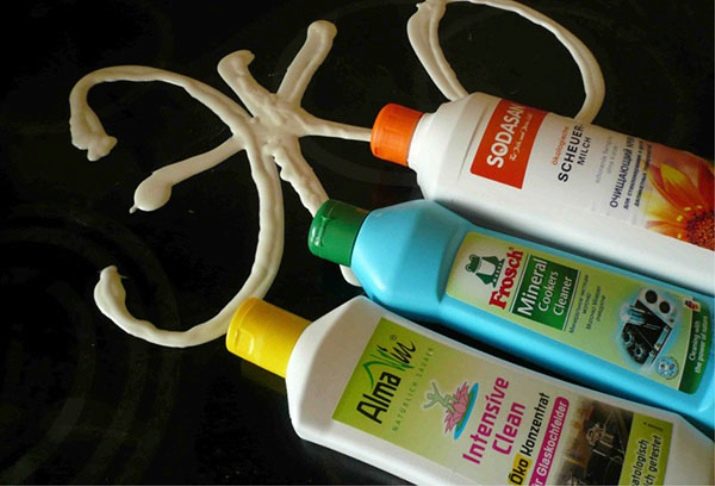
Many housewives often use cheaper analogues of the above tools for glass ceramics: Pemolux Cream and Comet Gel. They do not contain coarse abrasive particles that could spoil the plate. You can apply these products with a soft sponge, rinse with a damp cloth. Easy to use, but with too old deposits can cope with difficulty.
If you want the glass-ceramic plate to serve you for a long time and always please you with its beauty, you need daily gentle care for it. The real housewife will not cause any particular difficulties. If you choose the right tools and cleaning products, then to get an excellent result, it will take only a few minutes a day.
And now we recommend you to watch the video, which shows a clear example of how and how to clean a glass ceramic plate.
